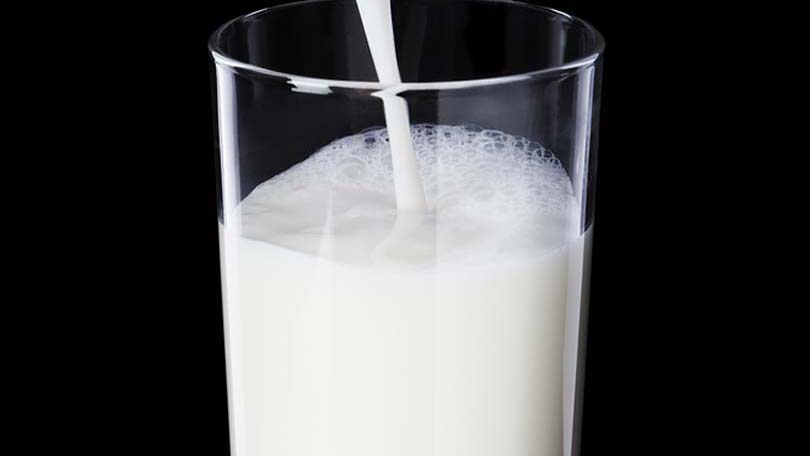Milk, which consists predominantly of water, is a fluid secreted by the mammary glands of female mammals meant to provide nutrition for newborn babies. Although milk varies between species, it usually contains (along with water) protein, calcium, and unsaturated fat. Some humans lose their ability to digest milk after childhood (known as lactose intolerance), but for those that do tolerate milk digestion, cow’s milk is often consumed and processed into cream, butter, cheese, and many other dairy based products.
A central characteristic of mammals, female milk production feeds nourishment to a baby before it can digest more complex foods. Colostrom is the first milk produced by a female, usually in the late stages of pregnancy or just after birth, and contains antibodies and other beneficial nutrients for the newborn. In some species, the newborn must receive colostrum to survive. So far, evidence from human studies suggests that human breast milk (instead of infant formula) is the optimal nutrient source for human babies. In many humans, the ability to process milk drops between the ages of two and five however, a certain mutation has caused some populations, specifically northern Europeans, to retain the ability to digest milk. In those milk tolerant populations, consumption of dairy products into adulthood is quite popular.
It is thought that man began consuming animal milk after the domestication of ruminant animals (cows, sheep, goats, etc) sometime around 6000-8000 BC. These animals can live on grass (a very abundant product in many parts of the world), and although meat and hide are useful, a cow can produce milk each year – providing a sustainable source of food and nutrition. Possibly discovered by accident, butter and cheese also became important staples, and use quickly spread through Europe, Asia, and parts of Africa. Today, cows are specifically bred for milk production, and dairy farmers produce milk on an industrial scale with automated milking equipment.
Raw cow’s milk must be processed by pasteurization to remove possible bacteria, and is often homogenized to prevent the separation of milk into a top layer of high fat cream and bottom layer of lower fat milk. Pasteurization, which some people believe removes beneficial microorganisms and nutrients along with the bad, is a process of heating the raw milk to a certain temperature to kill bacteria like salmonella or tuberculosis, then cooling for transportation. Though the milk is pasteurized, it is still perishable; an expiration date is printed on the milk carton, and the milk must be sold before the date passes. Homogenization prevents milk separation by breaking up fat globules; homogenized milk has a blander taste, is whiter, and is more resistant to developing an odd flavor. Unhomogenized milk (still pasteurized), now making a comeback on the west coast of the United States, is thought to be more easily digested by humans, but may not be as stable as homogenized milk.
While milk is now enjoyed all over the world and offered in many different varieties such as vitamin d, skim, 2%, chocolate, and other flavors, the health benefits and health detriments of milk are still under debate. During the 1950s, a system was developed to produce milk with different fat contents leading to the choices present in supermarkets today. A 1 cup serving of 2% cow’s milk holds approximately 285 mg of calcium (22%-29% daily recommended intake). It would also contain: nearly 8 grams of protein, vitamins d, a, and k, iodine for thyroid function, potassium and magnesium, and vitamin B12. The consumption of low-fat milk has been linked in various studies to a reduced risk of obesity and heart disease. Obese individuals that drink milk may avoid type II diabetes. High-fat milk, on the other hand, is higher in cholesterol, and may actually increase risk for heart disease when consumed in large amounts. Also, rBGH is now given to cows to increase milk production, but it can cause mastitis in the cow leading to inflammation and high levels of somatic blood cells (possibly a form of pus) in dairy products. Europe has a somatic cell limit for their milk, and Canada, New Zealand, Japan, and Australia have banned all milk from rBGH cows due to mastitis problems. For an individual with lactose intolerance, milk consumption will cause gas and diarrhea. Recent studies have indicated a possible link between high calcium intake and prostate cancer, although the exact amount of calcium absorbed by the body from a cup of milk is unknown.
Milk is sold throughout the world in plastic jugs, waxed cardboard containers, glass bottles, and even plastic bags. It is obviously an important part of human culture (we named the galaxy after milk: the Milky Way), and is used in thousands of products. The term ‘milk’ is even used for non-animal products like soy milk and coconut milk which provide a ‘milk’ substitute for the lactose intolerant. As humans, we should understand that milk was our very first introduction to food; even if we stray from milk later on in our lives due to allergy or fear of hormones, we have milk to thank (and our mothers) as our primary source of nutrition and life.






